Happy New Year's Eve! Exactly 7 weeks have passed since the cocoon was made, and finially emerged a Polyphemus Moth. Beautiful design on the wings, with streaks of pink and very distinct eyes. Truely a sight to admire. Though I'm glad I eventually only raised one caterpillar since the moth is rather big, but it was a very interesting experience. All together it took just under 3 months from egg to moth! I released it the following day on January 1st so it can continue it's life cycle. 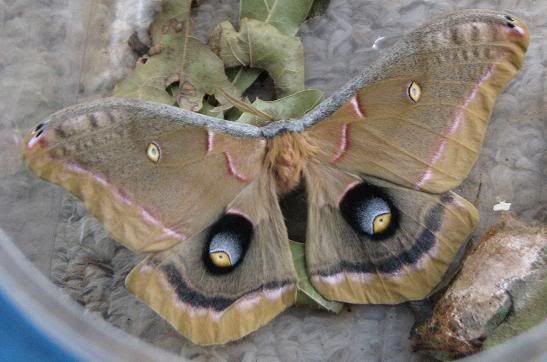
It's been about 6-7 weeks since those Polyphemus moth caterpillars hatched from their eggs. They've been eating alot and growing fast everyday. I started with over 20 larvae, but since I couldn't keep up with the amount of leaves they were all eating, I decided to release several outside. Now I'm raising just 1 single caterpillar and it has finially formed a cocoon! 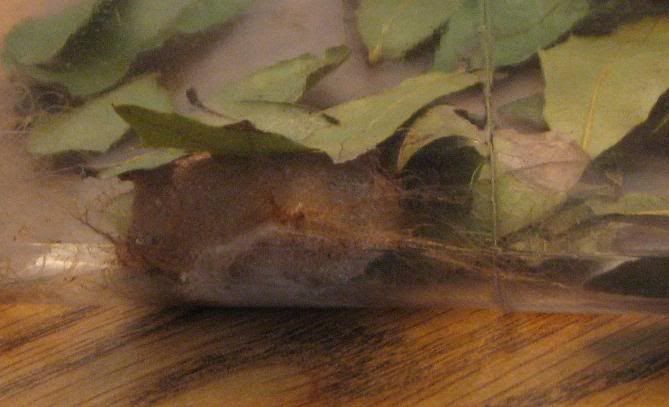
A couple weeks ago I pictured a young male Rose-Breasted Grosbeak that was using our feeder daily for awhile. Unfortunately I haven't seen it in the last couple of weeks so I think it has moved farther south to warmer night climates. Here's whats feeding on our bird seed mix now (black oil sunflower, safflower, milo, white millet, cracked corn):
Small group of Tufted Titmice
Male and Female pair of Cardinals
3 Mourning Doves feeding on the ground
Yesterday I spotted a new bird using the feeder that I believe was a female Painted Bunting. It only stayed for about 10 minutes and I wasn't able to get a clear photo. I've also spotted a single Carolina Wren hanging around every now and then.
Tufted Titmouse on a windy day, so cute!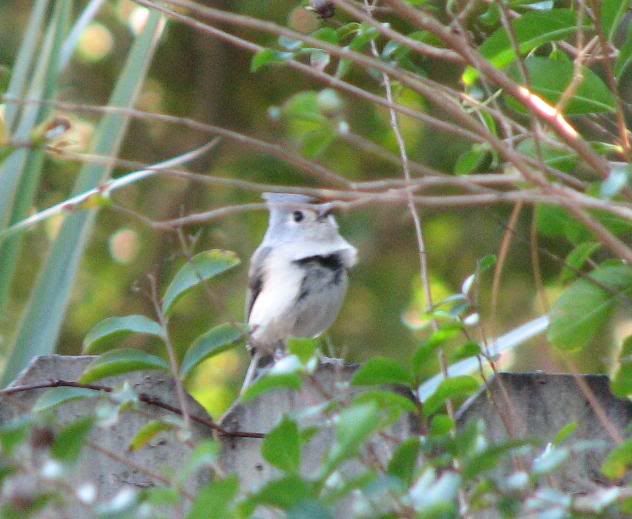
Caroline Wren sitting on our grill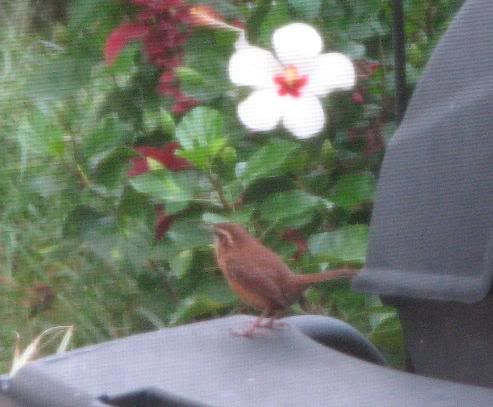
Today I placed an order for some more bird seed at Lowes and found a great mix in Scotts Colorful Bird Blend Seed. It has it ALL! nyjer seed, safflower, black oil sunflower seed, peanuts, white millet, sunflower chips, canary seed, raisins, red millet, juniper berries. Also grabbed a seperate 10 lb. bag of black oil sunflower seed since I normally mix more sunflower into the feeder mix. Lately squirrels have been eating more seed than the birds, so i'm trying something new with a Squirrel Bungee feeder, hoping to distract them away from the bird feeders with this. If that doesn't work, I bought a Squirrel Guard for the feeder pole. =)
Scotts 8-lbs. Colorful Bird Blend Seed
Garden Treasures 10-lbs. Black Oil Sunflower Bird Seed
Garden Treasures 16" Squirrel Guard
Birdola Squirrel Bungee Feeder and Cake Combo
Ordered some spring time flower seeds from Park Seed Co. This year I selected heat and drought resistant varieties. Also interested in growing the Ornamental Pepper for the first time. I went with the Marigold Golden Guardian because it's advertised to be the best for nematode control when interplanted with vegetables, plus I get 600 seeds in one packet. :)
Zinnia Zahara Starlight Rose
Nasturtium Hawaiian Mix™
Vinca Pacifica Burgundy Halo
Marigold Golden Guardian
Ornamental Pepper 'Sangria Hybrid'
The photos below are not actual pictures I took, just examples.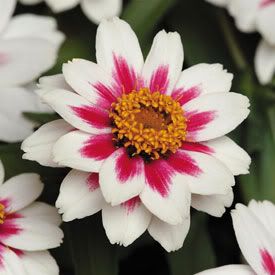
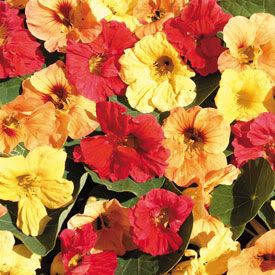


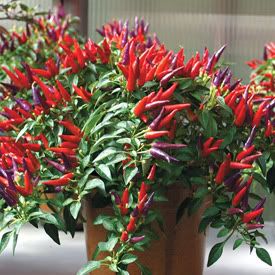
I planted some Radish Cherriette Hybrid seed in a long container today, using the Jungle Growth Flower & Vegetable soil mix purchased from Lowe's. Would've started the radish seed sooner but I've been waiting for the cooler weather. The average temperatures have been unusually hot in November this year, but now the night temps are finially in the 60's.
The photo below is not an actual picture I took, just an example.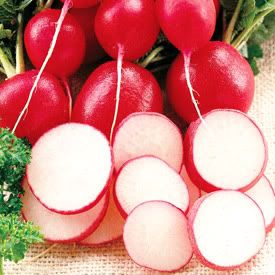
I setup my Burpee Ultimate Growing System again today, and sowed some flower seeds for the cooler weather. This system has a self-watering mat and makes germinating seed very easy. Just fill with water once and watch your seeds grow! I used 30 Burpee super growing cubes with the following seed in 30 tray cells. The Burpee growing system I have has up to 72-cells! =)
6 cells of Alyssum, Mountain Gold
9 cells of Pansy, Swiss Giant mixed colors
9 cells of Petunia Celebrity Red Morn
6 cells of Sweet Alyssum, Snow Crystals
For very small flower seed, just sprinkle the seed on top of the growing medium and lightly push down just enough so the seed gets good contact with the moist soil. I did not cover the seed with soil since they need LIGHT to germinate. (Update on 11-22-09: within 5-7 days, all varieties have germinated, GREAT STARTER SYSTEM BY BURPEE!)
While watching our bird feeders today, there was a different bird hanging around that we haven't seen before. It took some research, but I learned it's an immature male rose-breasted grosbeak. The immature male is difficult to identify because it resembles the colors of the female. However, you can see the rosey tint on it's chest and black on the wings, which the female doesn't have.
The adult male is absolutely stunning though, a very attractive bird. The link below shows an adult male rose-breasted grosbeak
adult male rose-breasted grosbeak picture
Information on the Rose-breasted Grosbeak

First bloom today on another tropical hibiscus plant, the Cosmic Dancer. I've had this one for a couple months now and this is the first time it has bloomed. Very bright colors
It's been 18 days since the larvae hatched out of those strange eggs
(see previous post here)
I originally had about 25 larvae, but they were eating so much that I had to keep refilling the oak leaves in the jar. So I released several and now I'm raising 4 caterpillars. I've read they get about 2 inches long before they start to form cocoons. Right now they are a little over an inch long. Will update again in a couple weeks!
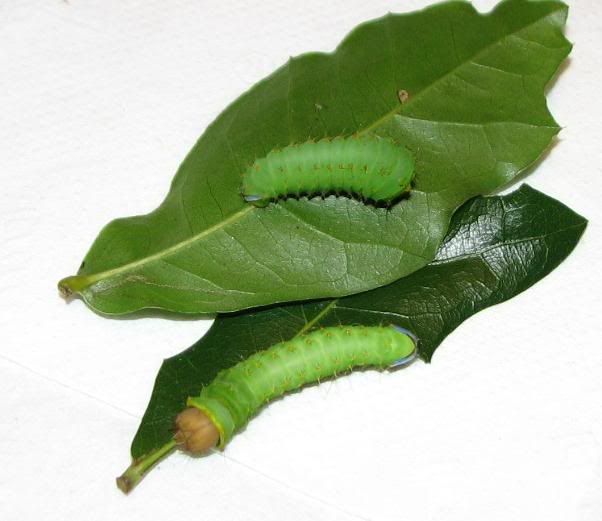
Spider mites are a warm weather problem for several hibiscus growers. They thrive in hot, sunny, and dry conditions when temperatures are high. The first sign of spider mites is when a leaf or two get yellow mottling mixed in its normal green, then slowly the entire leaf turns bright yellow then falls off. Soon more and more leaves turn yellow and fall off, which can be fatal to your plants. As the spider mites spread, you can see very fine webbing at the tips of the branches with yellow leaves.
I've been battling with spider mites for the last 2-3 weeks. As a safe treatment, it was recommended to spray the underside of leaves with a hard stream of water at least once a week. This washes off the spider mites and breaks their lifecycle. However, this method has been ineffective on our large hibiscus plant, which has lost most of it's leaves due to spider mite damage. One by one, the leaves would yellow and fall off within 24 hours. Amazingly, the hibiscus was still blooming well during this time.
I also tried the use of beneficial insects, the Green Lacewing larvae. I received the eggs in the mail from http://www.arbico-organics.com. When I noticed some of the eggs had hatched inside the container, I sprinkled the eggs and live larvae onto the hibiscus plant. This method will reduce the number of spider mites if applied correctly.
I also researched Miticides that were proven effective. The two name brands I found most popular are Forbid 4F and Floramite SC, both of which kill the adult mites AND the eggs. Forbid 4F seems to be the stronger of the two, since it kills all kinds of mites. Forbid 4F offers knockdown and residual control of mites and whiteflies. The active ingredient in Forbid is spiromesifen. I purchased a 5mL bottle of Forbid 4F on eBay, which makes 8 gallons and is more than enough for a small volume grower.
Compare miticides such as Forbid & Floramite here :
Miticide Chart 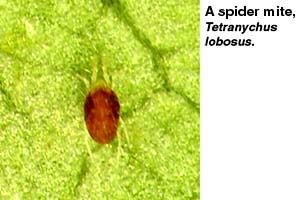
Ordered some vegetable seeds, radish and lettuce, from Park Seed Co.
Radish Cherriette Hybrid
Lettuce Green Ice
The small bird feeder in our backyard has been attracting some hungry wildlife. A pair of Tufted Titmouse birds are visiting the feeder everyday, and also a male & female Cardinal are using it frequently. 
Found some unusual egg capsules under some Hibiscus leaves, so I collected them and put them in a jar to hatch. Below is a picture of the eggs..
After a few days, the eggs hatched into tiny larvae that looked like caterpillars...
Very hard to identify these larvae, but after some research on Google, I learned the same eggs and same larvae belong to the beautiful Polyphemus Moth. The website below shows more detailed pictures on the lifecycle of this particular moth.
Website on the Polyphemus Moth
I'm feeding the newly hatched larvae oak leaves and there are about 20 babies in a jar right now. Will update as they get grow bigger. =)
Many colors of tropical hibiscus. The first blooms are here and these are my favorite hibiscus plants in our backyard. Both were purchased online from Tried And True Hibiscus Store. They are potted in 12" containers with Jungle Tree & Shrub potting mix.
Gator Magic
Dancing Fire
Are your hibiscus buds dropping off prematurely? Hibiscus bud drop is a sign that something is wrong. In some cases, it's the hibiscus gall midge. The gall midge is a small fly thats lays its eggs inside flower buds. As the larvae hatches from the egg, it feeds inside the flower bud until it drops to the ground. Once on the ground, the larvae exit the flower bud and enter the soil to pupate. After a couple weeks, an adult gall midge emerges from the soil and the whole cycle starts again.
If you suspect gall midges, it's relatively easy to identify. Look for yellowing flower buds and pick one off the plant for inspection. Carefully open the flower bud and look for tiny worm-like larvae inside. Another trick is to pickup any dropped flower buds and put them in a sealed ziplock bag. After a couple hours, check the sealed bag for small larvae that have exited the buds.
Most spray pesticides are ineffective as they don't come in contact with the larvae. The key to controlling this pest is to treat the plant with a systemic pesticide to kill larvae inside the flower buds and treating the soil around the plant to kill off any larvae that have entered the soil. For a systemic pesticide, I sprayed Bayer 3-in-1 (active ingredient: imidacloprid) on the plant. For soil treatment, I sprinkled Bayer Complete Insect Killer granules. On top of this, I made sure to pick up any dropped flower buds and put them in a sealed ziplock bag so the larvae could not escape into the soil. Be persistant to catch dropped buds to ensure your capturing the larvae. After a week or two, the flower buds will stop falling off and your plant will be midge free.
In late July, I purchased some hybrid tropical hibiscus seed on eBay. The seller shipped them from Australia, which makes them even more special. On eBay, it is normal for auctions to sell hybrid tropical hibiscus seed in lots of only 5 seeds, and they will usually name the Pod parent and Pollen parent.
Today I sowed 3 seeds from two different hybrid crosses
Tigerama X Bali Sunset
Rosalind X Dragons Breath
Preparing Seed for Planting:
Before planting, you want to nick the seed coat with a razor blade to speed up germination and prevent rotting. Do not nick the seed on the tapered end, where the root first emerges upon germination, as this will damage the seed. Always nick the seed on the rounded side (opposite side of tapered end).
Seed Starting Media & Sowing Instructions:
Always use a sterile media for starting hibiscus seeds, this again prevents the seed from rotting during germination. I recommend Jiffy Seed Starting mix as a good starting media. I also used Jiffy Peat Pots and had excellent germination rates. Seeds should be planted 1/4" deep and should germinate in about a week as long as temperatures are around 80 to 85° F. When you plant the seeds, don't overwater them. Misting with a spray bottle works really well. The soil should only be damp, not soggy and wet.
First time growing Hibiscus from seed. Today I sowed the following;
Hibiscus rosa-sinensis, Sweet Bippee x Dragons Breathe
All seeds germinated in 9 days.
Pictured here is an juvenile Red-Shouldered Hawk, the most vocal American hawk. Commonly found in woodlands near water, it can occasionally be found nesting in suburban areas. Found this one sitting on a fence just outside our bedroom window. Just look at those claws!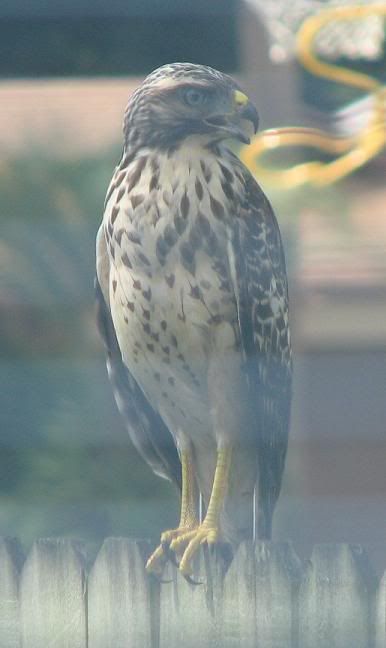
Found this large treefrog crawling around on our house after sundown. The Cuban Treefrog is an invasive (non-native) species. It is the largest of all treefrogs in Florida, growing up to 5 inches long. The toepads are much larger than other native treefrogs, which is a key distinguishing characteristic. They will eat insects and spiders, lizards, small snakes, and other native treefrogs. 


